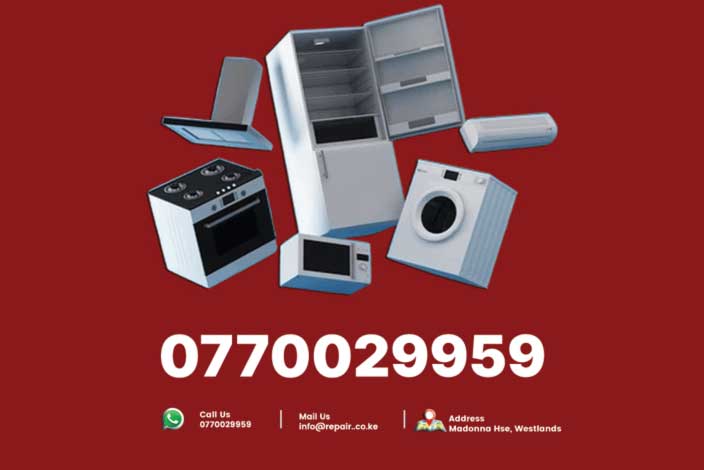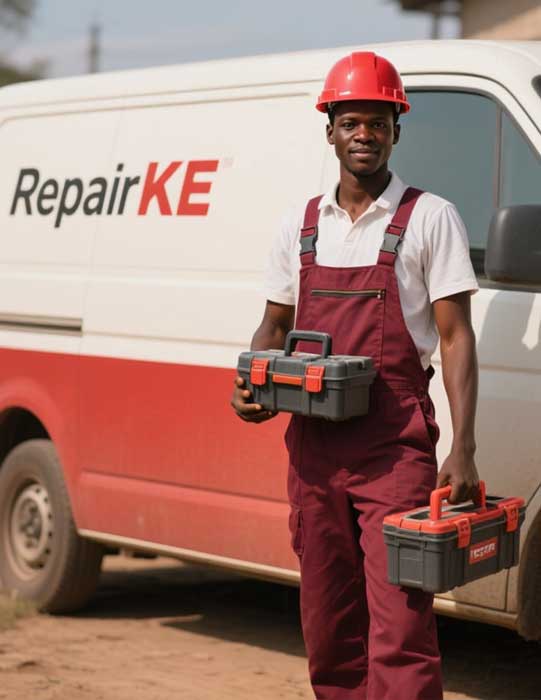WASHING MACHINE PROBLEMS AND HOW TO FIX THEM
Is your washing machine not working well? This guide will help you fix common problems. Your washing machine might not clean clothes properly, or water might leak out. Don't ignore these problems.
Some washing machine problems are easy to fix. You might only need simple tools or need to tighten a loose part. Other problems need a professional repair person. Read our tips to fix the most common problems. If your washing machine breaks down too often, you might need to buy a new one.
Read About Washing machine repair Service in Nairobi
1. WASHING MACHINE NOT CLEANING
My washing machine doesn't clean my clothes
When your washing machine doesn't clean clothes well, this is a big problem. This happens more often than people think. The most common reason is a blocked soap drawer or soap line. If soap and fabric softener can't reach your clothes, the washing machine can't wash properly. Also, if there is a blockage, soap, germs, and mold will build up and get on your clean clothes. This also happens when the filter is dirty or the drain pipe is blocked.
Try cleaning the soap drawer and filter before your next wash. If this doesn't work, you might need to check the drain (see below).
Other reasons include:
Too many clothes - If you put too many clothes in one wash, none of them will get clean. Too many clothes means they can't move around in the machine. Dirt gets stuck between clothes and there's no room for soap to work.
Wrong soap or wrong wash setting - Some soaps work best at hot temperatures, others at cold temperatures. Check this before buying soap. Also, some wash programs are made for specific clothes - like silk. Using the wrong setting might not clean your clothes well.
Why won't my washing machine finish its cycle?
If your machine is new, it should show an error code when it can't finish washing. If you see an error code, check your manual to find how to fix the problem.
When no error code appears, the problem might be:
Bad heating - If the machine stops in the first 30 minutes, the water might not be getting hot enough. The machine stops to protect itself. If the machine stops after 30 minutes, the water might be too hot. This usually happens when the temperature sensor is broken.
Can't drain water - If your machine can't empty the water between wash steps, it will stop early. Check for blockages in the pump filter and drain pipe.
Bad electrical connection - If there's a bad electrical connection, your machine might turn on and off by itself. This is hard to find, so call a repair person.
Too hot - If you used your machine for 5 hours without stopping, it might be too hot. Let it cool down and try again later.
Water leaks - Some machines stop if they think water is leaking. If you see water coming from the machine, check the pipes, pump, and door seal.
My washing machine won't advance to the next cycle
The most likely reason your washing machine won't move to the next step is a broken timer. The timer controls each step - wash, rinse, then spin. If the timer breaks, the steps can't move forward automatically.
Good news: you can replace the timer yourself or hire someone to do it. Just make sure you buy a timer that works with your washing machine brand and model.
Other possible causes:
Door latch or lock - The lock works when the door closes safely with the latch. It tells the machine it's safe to start washing or move to the next step. If this breaks, the machine doesn't know when it's ready to continue.
Drain pump - The drain pump removes extra water from the drum during each wash step. If the drain pump is broken and can't remove water or show it's finished, the machine won't continue. Strange noises during draining means there's a problem.
My washing machine won't spin
If your washing gets to the end but won't spin, it might be because you put too many clothes in the machine. This makes it unbalanced. If you put too many heavy towels in, the weight affects the sensors and shuts off the machine. Remove some clothes to balance the load and try again.
If it's not too many clothes, it could be these problems:
Broken door latch or lock - When the door closes fully, the latch locks and tells the machine it's safe to spin. The lock keeps the door shut while washing. If these are broken or worn out, the washing machine won't start spinning. You can check this by pressing the latch - if it doesn't click, it's broken. Also look at the plastic parts around the door lock. If they look worn or damaged, the signal might not work.
Drive belt - Find out if the drive belt is the problem by opening the door and trying to spin the drum by hand. It should be a little hard to turn - if the drum turns easily, the belt might need replacing.
Drain blocked - If the drum can't empty water, the spin cycle won't start. If you can still see water inside when spinning should start, you need to check your pipes for blockages.
Other causes include a broken drive motor or pump. If you're still not sure, call a professional to check your machine.
Washing machine isn't heating the water
Most modern washing machines will show an error code if there's a problem with heating. You can search for this error code with your machine's brand and model to find a fix.
Remember: just because you can't feel heat through the washing machine doesn't mean the water isn't hot. Most machines keep heat inside. If clothes are getting clean and there's no error code, the heating is probably working fine.
2. BAD ODOUR FROM THE WASHING MACHINE
Why does my washing machine smell bad?
You use your washing machine to clean clothes, but sometimes the machine needs cleaning too. Bad smells can come from a dirty door seal, moldy drum, or dirty soap drawer.
First, check the filter and drain pipe for blockages. Put towels on the floor to catch water and pull out the filter (usually at the bottom of the machine). Remove any material or debris.
Before checking the drain pipe, get a bucket because water might rush out when you disconnect it from the pipe under the sink. Look in both the pipe and the trap for anything blocking them.
If they're clear, you might need to clean the machine well. Mold, built-up dirt, and soap can all cause bad smells.
Washing machine has a burning smell
A burning smell from your washing machine can be dangerous. Immediately turn off the machine and unplug it.
The burning smell could be from a broken drive belt or motor, but don't try to fix it yourself unless you're trained. Instead, call a professional to find the problem.
3. Filling and draining problems
My washing machine won't drain
If your washing machine won't empty the water, it's either blocked or the pump is broken. You can tell which one by listening to the machine during a cycle.
If you can hear the pump running but water isn't draining, there's a blockage. If you can't hear the pump, something's wrong with it.
Coins, keys, or loose socks often cause blockages in washing machines.
First, unplug the washing machine and put down towels - water will leak out. Next, check the pump filter at the bottom of the machine and clear any debris.
Now check the drain pipe. This is usually connected to the waste pipe under the sink.
Unscrew this and empty the water from the pipe into a bucket or sink. Look in the pipe and waste trap for blockages and remove them.
If this doesn't work, check the pump for small pieces of clothing that might be wrapped around the spinning part.
Still nothing? The pump might be broken and need replacing, or you could have an electrical problem. A technician can help with this.
Why is my washing machine leaking?
First, check your soap. Using wrong products or too much soap can make too many bubbles. This can make the drum overflow and leak.
Next, make sure the machine sits completely level - if not, water can leak out.
If the machine still leaks, check the pipes. Tighten the connections and look for cracks or tears.
If water still leaks during the next wash, you might need to change the water inlet filter screens or the rubber rings in the water pipe. Debris buildup or normal wear can make these parts fail and leak.
If the pipe itself is leaking, it needs to be replaced. Also check the water pump.
If the leak is small and coming from the front, it could be the washing machine door. The rubber seal around the door can wear out with age, causing leaking. This is easy to replace.
My washing machine is overfilling
The most common reason for a washing machine filling with too much water is a broken water-level pressure switch. The pressure switch uses air pressure to sense how much water is in the machine. It tells your washing machine when to stop filling. If the switch breaks or gets blocked, the machine won't know when to stop.
There's also a tube connected to the switch. If this comes loose, the machine could also overfill.
Unplug your washing machine, remove the top panel, and check the pressure switch. Each machine is different, so check your manual first.
Another possible problem could be the water inlet valve. This electronic valve controls water filling. If the valve is broken and doesn't close when the water reaches the right level, it will overfill.
4. Washing machine noise problems
Why is my washing machine so noisy?
Whether your washing machine hums, buzzes, or vibrates, if the noise is too loud, you shouldn't ignore it.
Letting your washing machine make loud noise while it's still running could break the machine completely.
Possible causes include:
- Worn drum bearings
- Unbalanced washing machine feet
- Objects stuck in the outer or inner drum
- Too many heavy clothes
Strange noises from a washing machine are different from the machine just being loud. Sounds like rattling, scraping, or knocking shouldn't be ignored, even if they're quiet.
Research from Which? members shows the most common reasons for strange washing machine sounds are coins and bra wires. We tested by putting coins into washing machines and found you have about 15 minutes to hear them rattling before the wash sound covers them up. Bra wires make more of a scratching sound.
Why does my washing machine shake, move and vibrate?
If your washing machine won't stop vibrating or even moves around the room during washing, it probably needs to be made level. Every washing machine must sit level on a flat surface - if it doesn't, it will shake, especially during spinning.
Check if the machine is level using a bubble level tool. If it isn't, adjust the feet underneath.
If the feet are level, the floor might be causing the problem. Uneven floors can create a shaky machine. You can try putting it on a strong piece of wood and adjust the corners to make it even. Unbalanced washing loads can also create lots of movement. For example, putting eight large bath towels and a bed sheet is too much for a 6kg washing machine - it will vibrate.
If you just moved or your washing machine is new, make sure you removed the transit bolts. These bolts are attached to the back of the machine and keep the drum locked while moving.
Machines usually have three or four bolts that must be removed before you can use it. If they aren't removed, this will cause vibrations and could damage the machine permanently.
How to fix strange sounds coming from a washing machine
Turn off and fully unplug your machine before doing anything. If your machine is in the middle of a cycle when it starts making noise, follow the instruction manual for stopping and draining it. If you think something is stuck in your washing machine causing odd noise, check the rubber seal and drum - our tests showed coins usually get stuck here.
After, check if lost items ended up in the filter. Follow the manual instructions to check and clean the filter.
If you still can't find the problem, there's a risk it slipped between the rubber seal and metal drum and fell into the surrounding plastic container. Items that don't get washed into the filter can be thrown around violently by the drum's spinning, especially during the spin cycle.
The coins we use in tests have been thrown so hard by the drum that they broke through the outer plastic container, which can flood your kitchen and ruin your machine.
If something gets stuck in this area, it will make a very loud noise when the machine runs, especially during spinning. If you think an item is caught here, stop the machine and call a repair person.
The cost of removing the drum assembly for many washing machines is very high. Combined with the call-out cost, it may be cheaper to buy a new washing machine.
5. Washing machine door problems
My washing machine door won't lock
If your washing machine door won't lock, first check the door and handle - is there any visible damage that would stop the latch from working? If the door looks fine, the most likely problem is a broken door lock mechanism. This can be repaired. People who like DIY should find this fairly simple, but always check the instructions for your specific model.
Another, slightly harder fix would be repairing the control board. If the lock mechanism is fine but the control board isn't connecting with it, the machine won't know when to start. Call a professional to test this.
My washing machine door won't open
There are many reasons why a washing machine door might not open, including:
Drainage - Like all washing machines, if extra water can't drain away from the drum properly, not only will the cycle stop but the door will also stay locked. If you can see water left in the drum at the end of the wash, you likely have a blockage in the drain pipe or pump. See above for how to drain water from your machine.
Door damage - If the door, handle, or latch has any damage, this could stop the machine from opening. Check your door before calling a repair person.
Broken lock mechanism - The lock mechanism inside keeps the door shut while washing. If this is damaged, the washing machine won't know the wash has stopped and won't signal that the door can open. Finding and replacing this can be tricky, so call a professional.
How to open a washing machine in an emergency
Opening your washing machine door in an emergency isn't easy - or quick. And depending on your model, there might not be a solution. For safety reasons, most machines lock as soon as the cycle begins and don't open until the cycle is complete. However, some machines have an emergency drain or unlock feature you can use if the power goes out.
If your model doesn't have this feature, you can push the pause button. Once the water has drained away, you'll be able to open the door. You can restart the cycle by pressing the start button again.
6. Washing machine has a dodgy detergent drawer
Soap drawers often get buildup of mold, soap residue, and - in extreme cases - a black jelly-like substance. As well as looking bad, if it builds up it can stop soap from getting into the machine and water from entering the drum. Most problems with soap drawers can be fixed by cleaning them well. Manufacturers recommend you do this regularly anyway. If your soap drawer is actually broken, you can buy replacements from the manufacturer.
Remove the drawer completely from the washing machine. While wearing gloves, use warm water and dish soap to scrub it well. You'll also want to clean the space where the drawer sits in the machine, paying special attention to the holes on top.
It's also worth doing a service wash on your machine. This means running a very hot wash or special program - check your manual for details. Doing this once a month will help keep dirt and grime away.
The only downside is that washing on hot temperatures costs more. In our tests, we measure how much water and energy each machine uses, so we can give you an average running cost.
7. Washing machine won't turn on or off
My washing machine won't turn on
When your washing machine won't turn on, first check the connection and electrical outlet. Is it plugged in? Does the outlet look damaged? Can another appliance get power from the same outlet? It might not be a problem with the washing machine.
Once you've confirmed the electricity supply isn't the problem, check the power switch on the machine. Does it press down normally? Does it stay pressed? Does it look broken? If so, replacing the power switch could fix it.
If the display panel lights up and you can select programs but cycles won't start, the door latch might be the problem. This latch tells the lock mechanism, and therefore the machine, that it's safe to move to the next cycle. If it's worn or broken, the machine won't start a wash. You can try to fix this yourself, but if you don't like DIY, call a local repair person.
Another mechanical problem could be the door lock mechanism. This isn't the spring that latches the door shut but the electrical mechanism inside that keeps the door shut while washing. Finding and replacing this can be tricky, so call a professional.
My washing machine won't work after moving house
Before doing anything, make sure you removed the transit bolts. These are bolts in the back panel that keep the drum locked while the washing machine is being moved. If your machine is vibrating or not running correctly and these are still in place, that's why.
If the bolts have been removed and it's still not working, it might be a problem with installation.
Our guide explains how to install a washing machine properly - take a look.
It's also worth noting the problem might not be related to the move. Check our other common problems to help find the issue.
My washing machine won't turn off
If the power to your washing machine won't turn off, your power button may be broken. But if wash cycles won't stop and instead continue after every spin, it's probably the timer or control board.
The timer tells the machine when to move to the next phase of the cycle. The control board tells it what program to use. If either of these is damaged or worn, the machine may continue to run until you manually stop it. Both parts can be replaced, but the control board should be done by a professional.
If the pump or drain is blocked, stopping the removal of extra water, the machine will also continue to run - it won't advance to spin or finish until the water is drained. Check both for blockages before paying for a repair visit.
8. Washing machine won't fit under our worktop
Most front-loading washing machines are designed at standard size: 85cm high and 59.5 to 60cm wide. Most kitchen cabinets are also designed for this size. But if you're struggling to fit the machine under your worktop, you could try lowering the machine's adjustable feet to gain a few extra centimeters. Getting help fixing your washing machine or replacing it






